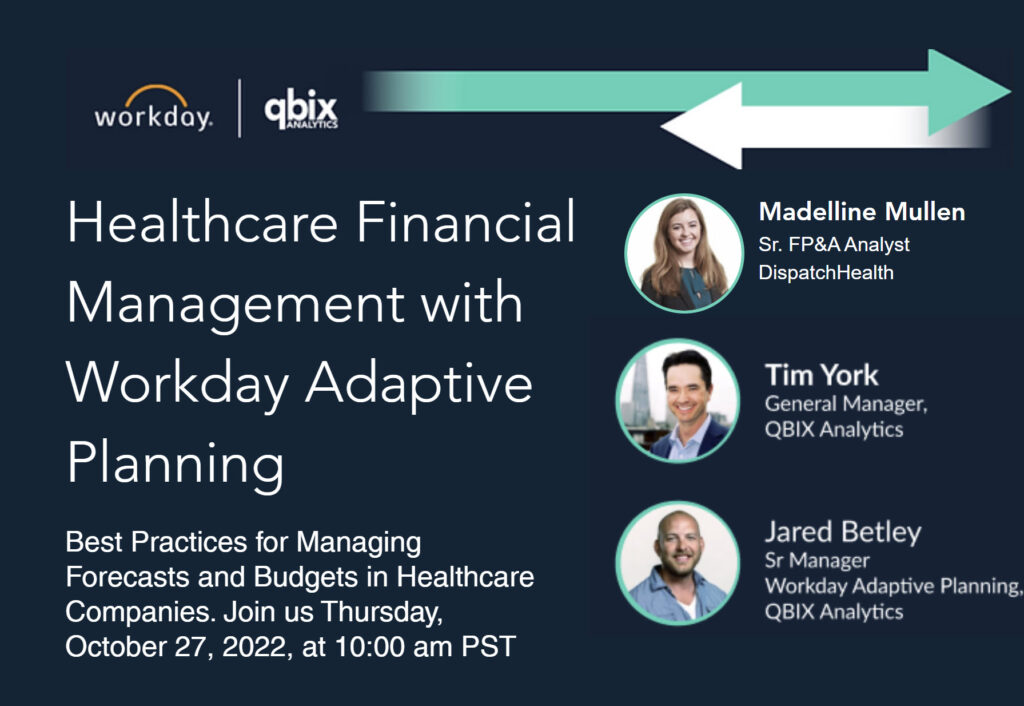
Table of contents
Planning for the future in any industry can be very challenging. Each business has its own set of challenges as well as common issues shared by almost all businesses. These challenges include sales and revenue planning and forecasting, data consolidation and reporting, and version control to name a few. With that being said, planning and forecasting in the healthcare industry brings its own set of challenges. Some of these major pain points for healthcare businesses include revenue modeling under the Fee-For-Service model, personnel classifications and Capex modeling. In this post, we will highlight these pain points as well as discuss strategies for mitigating them using Workday Adaptive Planning for Healthcare.
Understanding Pain Points
As previously mentioned, there are a few challenges that are uniquely specific to the healthcare industry. These include revenue modeling under the Fee-for-Service model, personnel classifications and Capex modeling. In this section, we will take a deeper dive into what makes these aspects of the planning process especially difficult for healthcare firms.
Revenue Sharing and Fees-For-Service
Within healthcare firms there are a number of ways to split revenue between the service provider and the firm itself. The most common way of doing this is through a Fee-For-Service Model, or FFS. In this model healthcare providers and physicians are reimbursed based on the number of services they provide or their procedures and payments are not bundled. This means that a payment is made for each individual service and physicians are rewarded based on the volume and quantity of services regardless of outcomes. As a result, firms often struggle to model revenue as it is a function of services provided and not expected visits.
Another more traditional form of payment is the revenue sharing model. In this model, the total amount of income generated by the sale of goods or services is divided between the stakeholders or contributors. These revenue share agreements are likely very different from Physician to Physician and require a lot of consolidation in order to forecast expected revenue based on the different agreements.
Personnel Classification
Another common issue that arises when planning within healthcare firms is that of personnel classification. Within your business, there may be a large variety of different personnel types. Some classifications include full-time employees, part-time employees, contractors, Physicians, Physician Assistants, and more. All of these different classifications come with different hourly rates and expenses that only add an additional layer of complexity to the planning process. This can become especially difficult as firms try to acquire new businesses and integrate them into their own as some classifications may not carry over.
CapEx Modeling
One key aspect of all healthcare firms is their Capital Expenditures. CapEx includes any funds used by a company to acquire, upgrade, and maintain physical assets such as property, plants, buildings, technology, or equipment. These expenditures are recorded on the balance sheet instead of expensed on the income statement. CapEx in healthcare is extremely important as firms have a large sum of physical assets that are vital to administering care.
On top of the necessary equipment such as surgical supplies and imaging equipment, healthcare firms often have a number of locations and clinics to account for, including adjustments on these various expenses. Tracking these various expenses, especially in an unintegrated system, often causes many hours of consolidation and backtracking in order to confirm the correct number.
How Can Workday Adaptive Planning Help?
Workday Adaptive Planning provides an integrated and centralized platform that brings power to decision-makers. The process begins with a forecast engine that calculates models based on various inputs. This engine can be an existing model developed in an external tool like excel or modeled directly in healthcare adaptive planning software from Workday.
Once this model is set, users can update and track the various inputs to the model in a single source of information. This centralization makes it easier to track changes and previous data. Different models can be implemented for different departments, making it easier to track different revenue share agreements and model different services under the Fee-For-Service model. Similar adjustments can be made in order to model different personnel classifications. These expected outputs are then connected with your ERP system which is all fed back to your financial statements to compare actuals and gain high visibility into all parts of your business.
This process is completely customizable and can be recreated within different departments of your business. Within healthcare, this is extremely valuable as different providers may have different models for forecasting visits and services as well as be applied to different locations. Once these customizations are made, new dashboards can be created to connect the entire business.
Other Benefits of an Integrated Platform
There are a number of different reasons to move your financial planning and analysis out of excel. As previously mentioned healthcare adaptive planning with Workday provides a single source of truth for your business and saves countless hours of data consolidation. This centrality also provides an opportunity for version control as changes are tracked and saved within the system. Additionally, Workday’s Adaptive Planning provides dynamic reporting and customizable dashboards as well as what-if scenario planning so that decision-makers can receive the information they need quickly.
Join Our Workday Adaptive Planning and Healthcare Webinar
QBIX Analytics has a number of experts ready to help you get started on improving your planning process. Join us on Thursday, October 27 at 10:00 am PST to learn more about how Workday Adaptive Planning can increase your business agility. We will be joined by Madelline Mullen, Sr. FP&A Analyst at DispatchHealth.